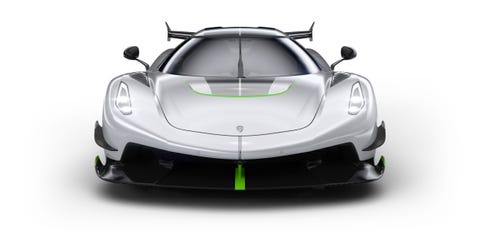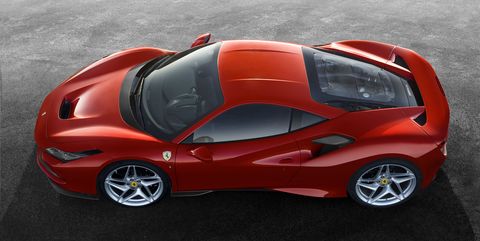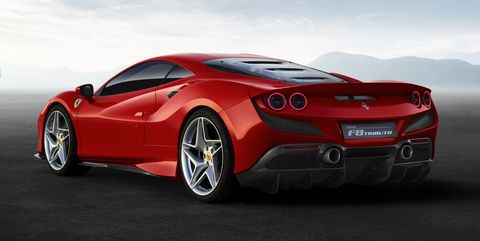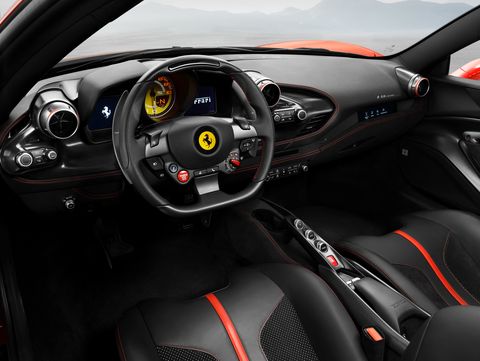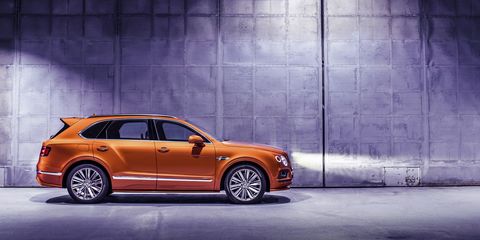Bugatti La Voiture Noire Revealed As Most Expensive New Car of All Time
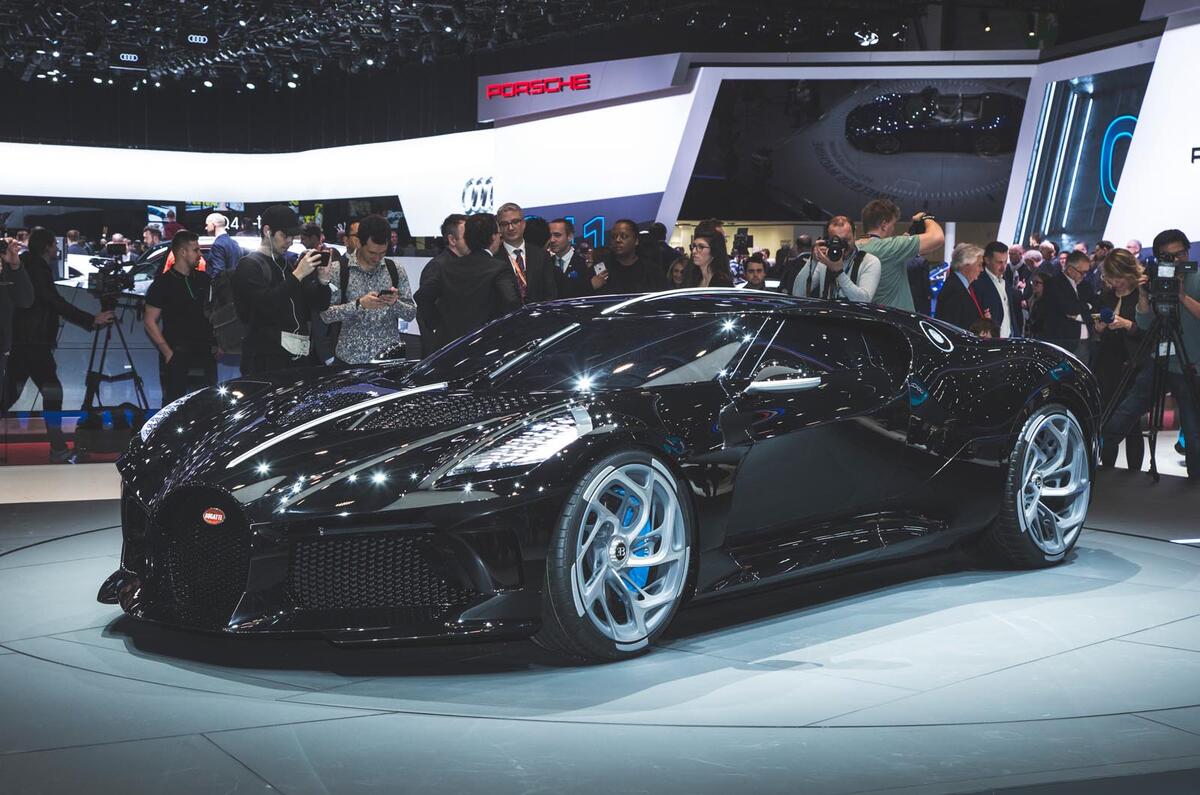
La Voiture Noire, priced at €11 million (around £9.45m) before taxes, has already been sold. If sold in the UK, the price would be some £11.3m including VAT.
La Voiture Noire, which arrives in Bugatti’s 110th anniversary year, features aggressive styling up front with a more pronounced grille than either the Veyron or Chiron, while the headlights recede back above the wheel arches rather than being placed horizontally above the bumper, which now juts out sharply.
While the styling isn’t entirely reminiscent of the smooth coupé contours and elongated bonnet of the original Atlantic, the most definitive stylistic aspect has been retained: the dorsal seam running up along the bonnet, between the windows and over the roof of the body (although the rivets have been left out).
At the rear, a continuous rear light runs along a grille-like back end, McLaren P1 style, with the company name illuminated in white below. All this sits above a bespoke exhaust set-up comprising six separate pipes running away from the car’s 1479bhp 8.0-litre 16-cylinder engine. From the specs, it is likely to be the same engine used in the Chiron.
The car is based on the Chiron but the wheelbase has been lengthened slightly. Bugatti is understood to have made money on the project.
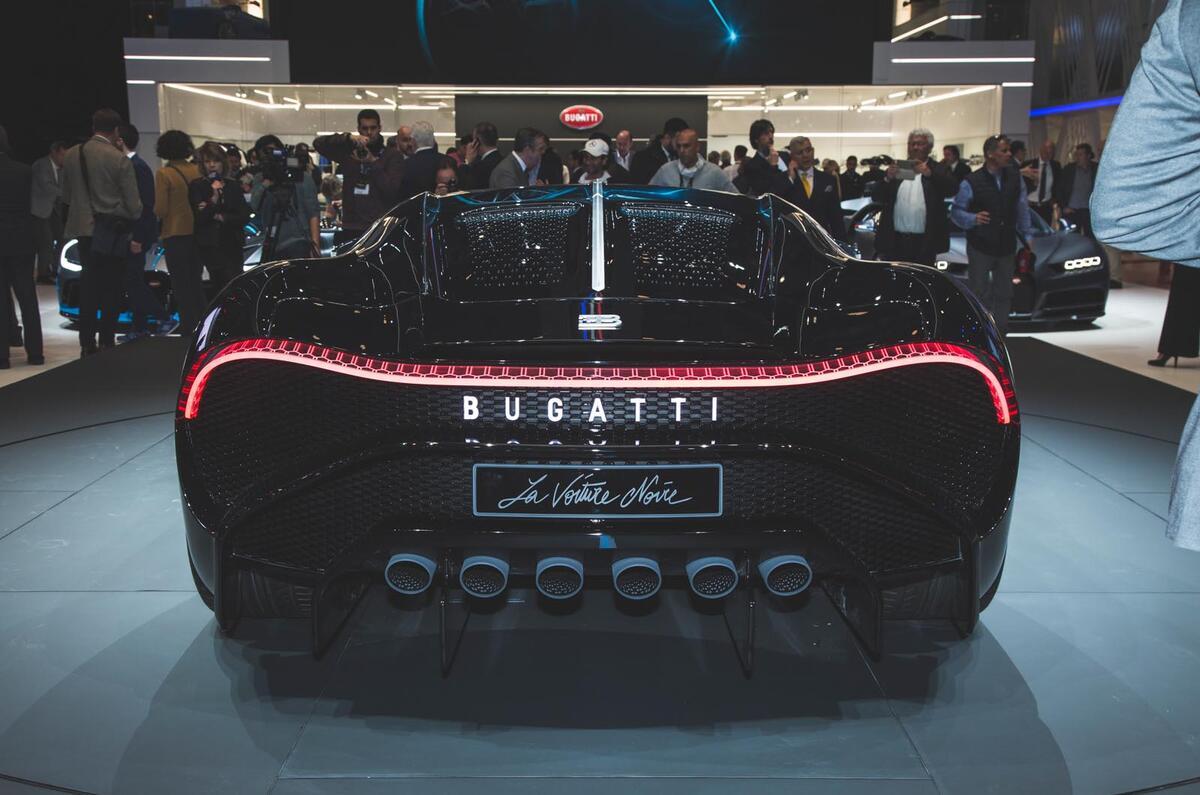
Bugatti has not named the buyer of the car, saying only that they are a ‘Bugatti enthusiast’. Stephan Winkelmann, Bugatti boss, said that Bugatti approached the customer direct about buying the car. The average Bugatti owner has around 30 cars, Winkelmann added, and the firm had a list of customers who may well be interested in products like the
“The true form of luxury is individuality,” said Winkelmann. “La Voiture Noire is now at the cutting edge of automobile production. It is a sculptural beauty with unique technology, the ideal grand tourer.”
“With La Voiture Noire, we are paying homage to our heritage and bringing speed, technology, luxury and aesthetics forward to a new era,” Winkelmann continued. “With our automotive haute couture, we have shown what Bugatti is capable of.”
By: Autocar, March 6, 2019
For more cars, visit: https://www.autocar.co.uk/car-news/motor-shows-geneva-motor-show/bugatti-la-voiture-noire-revealed-most-expensive-new-car-all
Source: https://www.autocar.co.uk/
Pininfarina Battista First Look: The Fully Electric, Nearly 1,900-HP Hypercar

It has 1,874 horsepower and 1,696 lb-ft of torque. It’ll hit 60 mph in 1.9 seconds, 100 mph in 4.3 seconds, and 186 mph in 11.8 seconds. Quarter mile? Gone in 9.1 seconds. Top speed? An autobahn-busting 218 mph. And there’s not a single turbocharger or camshaft or piston to be found. Welcome to the shocking future of the hypercar. Welcome to the Pininfarina Battista, one of the star cars of this year’s Geneva auto show.
The name is steeped in history. Battista ‘Pinin’ Farina founded his eponymous coachbuilding company in Turin, Italy, in 1930. The 1947 Cisitalia 202 coupe he designed was the first car to become part of the Museum of Modern Art’s permanent collection in New York. Pininfarina has also designed and built cars for Ferrari, as well as Alfa Romeo, Peugeot, and Cadillac (remember the Allante?), among others. But the Battista is a digital-age, crowd source-era hypercar, combining traditional notions of Italian design and craftsmanship with financial and technological resources that simply weren’t available 10 years ago.
Pininfarina SpA, which will build the Battista in Italy, is today majority owned by Indian automaker Mahindra, best known in the U.S. for its range of tractors and the Roxor off-roader, an ancient CJ Jeepclone it has built for decades. Automobili Pininfarina, which developed with the Battista concept and will sell the car, is 100 percent owned by Mahindra and staffed by highly experienced executives and engineers who have variously worked for Porsche and Pagani, Lamborghini and Bugatti, as well as Alfa Romeo and Audi.
Designed by Pininfarina SpA, the Battista at first glance looks vaguely like a reworked Ferrari 488. The Ferrari vibe is perhaps understandable, given the company’s long association with Maranello, even though the brief for the Battista came from Automobili Pininfarina design director Luca Borgogno, who worked at Lamborghini’s studio in Turin, most recently on the Urus SUV. Automobili Pininfarina insiders insist, however, the carbon -iber monocoque and body panels are all new and unique, a fact substantiated by doors that are cut into and are hinged at the roof, and swing forward and upward like those of a McLaren 720S.
The Koenigsegg Jesko Has 1600 HP and Promises a 300-MPH Top Speed
Koenigsegg will build 125 Jeskos in two variants. The track-focused version you see here is designed to produce more than 3000 lbs of downforce with Koenigsegg’s revolutionary Triplex suspension at front and rear. The low-drag Jesko version is a more road-friendly machine with a standard front suspension that leaves enough room in the front trunk to stow the removable targa roof.
And good news: No matter which spec you choose, the Jesko will be homologated worldwide—unlike some other extreme performance cars that aren’t road legal in certain nations.
We’ve talked about how special the Koenigsegg V-8 is before. For its last appearance before Koenigsegg goes electrified and camless across the board, the team has really gone the extra mile. You get 1280 horsepower on pump gas, or 1600 hp on E85. That’s partly because the Jesko’s V8 has a flat-plane crank that weighs just 27.5 lbs, milled from a solid steel billet in southern Sweden. To reduce thevibration you’d get from a flat-plane crank engine while as it approaches 8500rpm, Koenigsegg’s engine architect, Dr. Thomas Johansson, came up with new super-light connecting rods that are made from an ultra-strong Swedish steel alloy. Including the bolts, they weigh 19 pounds, which makes them exactly as light as the titanium rods of the Regera engine, but even stronger. Then, there’s the pistons.
They weigh 0.63 pounds each, with a ceramic-coated curved face that happens to be the strongest in production. As a result, they can take a crazy amount of pressure while allowing the long-stroke V8 to rev to 8500 rpm.
The Jesko may not use Koenigsegg’s camless Freevalve heads, but the ones it has are cast by Formula One suppliers Grainger and Worrall, with an extra “tumble” valve on the intake side to increase turbulence in the air-fuel mix.
Koenigsegg’s even-larger turbos would mean even more lag, but the Jesko’s engine features a clever system that uses pressurized air to spool up the compressor wheels and heat up the catalytic converters more quickly on cold start. In principle, the system is similar to one used on Volvo’s PowerPulse diesel, but Koenigsegg came up with a patent-pending turbo housing design, with pressurized air stored in a carbon fiber tank and blasting into the turbos at up to 290 psi. And with the catalytic converters reaching operating temperature in no time, this twin-turbo Koenigsegg V8 will comply with future global emission standards planned for as far away as 2026.
 More air demands more fuel, so the engine now sports three fuel injectors per cylinder. The third injector lives in the intake plenum, squirting in fuel directly above the intake runner for each cylinder. The extra blip of fuel also cools the cylinder, making for a cleaner combustion and less strain on the engine at the top of the power range.
More air demands more fuel, so the engine now sports three fuel injectors per cylinder. The third injector lives in the intake plenum, squirting in fuel directly above the intake runner for each cylinder. The extra blip of fuel also cools the cylinder, making for a cleaner combustion and less strain on the engine at the top of the power range.
Koenigsegg also threw in individual in-cylinder pressure sensors, a first for road cars. This allows the in-house-designed Engine Management System to monitor and control each cylinder at maximum efficiency. All this results in 1106 pound feet of torque to accompany your 1280 pump-gas horses.
If you thought the Regera’s direct-drive system was nuts, buckle up for what Koenigsegg calls the Light Speed Gearbox.
The LST has nine forward gears and seven wet multi-disc clutches. Yet at 198 lbs—complete with all fluids, clutches, oil pumps, and the starter motor and flywheel—it weighs significantly less than the average dual-clutch transmission. It’s also half as long as Koenigsegg’s previous seven-speed, with a two-stage shifting method that allows for nearly instant gear changes. And yes, the Jesko even has a stick, sort of.
Koenigsegg says they developed this transmission to have ultimate power on demand, and thanks to the simultaneous engaging and disengaging of those clutches, it offers “near light-speed” gear changes both up and down. That’s because, unlike a one-gear-at-a-time conventional DCT which tries to predict your desires by pre-selecting the next gear, the LST can jump to any forward gear immediately, even as far as five gears away.
With the LST’s seven clutches and the V-8’s anti-lag system, Koenigsegg says there’s absolutely no drop in torque as you accelerate through the gears.
By: Mate Petrany, March 5, 2019
For more cars, visit: https://www.roadandtrack.com/car-shows/geneva-auto-show/a26617787/koenigsegg-jesko-geneva-motor-show-photos-info-specs/
Source: https://www.roadandtrack.com/
Ginetta’s 600HP Supercar Is Road-Legal LMP3 Tech
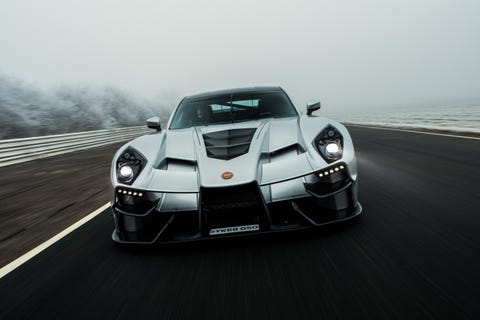
I don’t think speed cameras will be able to read the new Ginetta supercar’s front plate, a possible plus in case you find this nearly $530,000, LMP1-inspired, front mid-engined British supercar to be a great idea. Ginetta says production will be limited to 20 units in the first year, with 60 percent of the 2020 allocation sold already. That means there are eight more 2020 cars to go before Geneva, where Ginetta will tell us the name of its their 600-horsepower carbon fiber rule-bender.
Ginetta claims this 104-wheelbase two-seater has a “mid- mid-engined layout,” not front mid-engined, as you might expect. The naturally-aspirated, dry-sump V8 is pushed so far back in the carbon monocoque/aluminum honeycomb sandwich chassis that you could put another V8 in front of it. But you won’t need to, since the stock one packs 600 horsepower and 516 foot-pounds of torque. It’s Ginetta’s GT3/LMP1 racing-delivered motor with a billet block and forged inners.
The result is a weight distribution of 49 front/51 rear, with a minimum dry weight of 2535 lbs. ‘Dry weight’ of course refers to a car that has no fluids in it, which means you can’t drive it, but the figure remains promising.
Ginetta’s supercar also has a bespoke transaxle with a carbon fiber propshaft, and a six-speed sequential gearbox featuring full synchromesh and precision ground helical gears, connected to a Torsen-style limited-slip differential. This much torque also demanded a four-plate carbon/hydraulic clutch, with anti-stall functionality.
The steering is hydraulic, while the billet-milled pedal box’s left side is connected to 14.1-inch carbon ceramic brake discs, hidden behind Ginetta’s in-house designed 19/20-inch wheels. The standard tires are Michelin Pilot Sport 4s, with 305-wide rubber at the rear.
McLaren 720S Spider Review
A car capable of putting a 200mph breeze across your bonce. Or perhaps more pertinently the roadster version of our favourite current supercar, McLaren’s 720S. Now, you know the score. Take supercar, remove roof, receive roadster. Only it’s never that simple because 700bhp supercars need to be stiff, and so in addition to the roof’s motors and panels, they need extra bracing and strengthening. End up weighing 150kg more.
You’re one step ahead of us, no doubt. McLaren’s dedication to a super-stiff carbon fibre tub instead of the aluminium monocoque used by almost all rivals means weight gain is kept to a minimum – just 49kg here – and strength isn’t sacrificed. That’s not to say both use identical Monocage II tubs. No, McLaren had to slightly alter the header rail to incorporate a central securing latch for the retracting roof.
OK, there’s a bit more to it, which has led to the 720S Spider’s chassis tub gaining an extra letter. This is now Monocage II-S. The changes mainly incorporate a new carbon rear section behind the seats (basically a frame for the roof to fold into) and alterations to the hinges and sealing as the door glass is now frameless.
The roof. Moved by electric motors rather than hydraulics, so it’s quieter. And it moves fast, too. Just 11 seconds to complete the sun vs rain routine. And at up to 31mph. McLaren is so proud of this lid, it’s applied for three patents on it.
The 720S coupe gained a reputation for habitability, thanks in no small part to excellent all-round visibility. This is an area roadsters typically perform badly in – somewhat ironic in a car designed to deliver maximum fresh air potential. But McLaren claims to have worked hard to keep the back deck low and that the glazed buttresses improve over-the shoulder visibility by literally some per cent.
Otherwise McLaren has copy/pasted coupe to roadster. Same hydraulic cross-linked variable dampers and active aero package (although your top speed is ‘only’ 202mph with the roof down, 212mph raised), and the 4.0-litre V8 twin turbo is carried over unchanged. But that’s still 710bhp and 568lb ft to do the shoving, so 0-62mph takes 2.8secs and 124mph is dusted in 7.9secs. The Coupe is obviously faster… but only by 0.1secs to 124mph. Basically nothing.
The biggest gain therefore is not the additional 49kg, but the fact McLaren charges £580 for each of those kilos. Yep, while the coupe starts at £208,600, base price for the Spider is £237,000. And like the coupe, most buyers upgrade to either Sport or Luxury specification (£246,990). And then use that as a jumping off point to greater things. Like the eleven carbon fibre option packs fitted to the car you see here that together add another £42,490, helping boost the total list price of this Luxury spec car to £321,900. Ouch.
By: Top Gear, February 27, 2019
For more cars, visit: https://www.topgear.com/car-reviews/mclaren/720s-spider
Source: https://www.topgear.com/
The 2020 Ferrari F8 Tributo Takes the Mid-Engined Sports Car Back to Its Roots
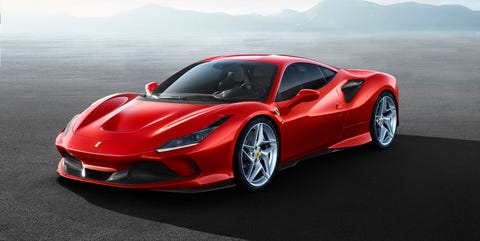
Maybe it’s because every new Ferrari debuts in a scorching coat of red paint, or, maybe it is Ferrari’s recent transition to gentle visual redesigns of its products that makes the new F8 Tributo appear, well, familiar. Is it that different from the 488GTB it replaces? Break out that zoom function in your browser or on your phone, look closer, and the F8 Tributo’s familiar visage isn’t quite what it seems.
The very literal name Ferrari has bestowed on its 488GTB replacement, F8 Tributo, is a hint as to what it’s up to here. This is a return to form, on an optics level, for Ferrari’s mid-engined eight-cylinder sports car, which experienced a hard break when the 458 Italia arrived in 2010. That car’s form valued function over beauty, and it had two single round taillights instead of four; when it evolved into the 488GTB, Ferrari really let its hair down and turbocharged its V-8, an act of autoerotic suffocation that exploded the engine’s power at the expense of the free-breathing noise we’d come to expect from Maranello’s eights. It still had two taillights.
The F8, then, is a true tributo—Italian for tribute, in case that wasn’t obvious—to mid-engined Ferraris gone by. There are, for example, four round taillights poking from its tail, as there have been on similar models going back to the 308 (and before that, the not-quite-Ferrari Dino cars). The V-8 remains turbocharged, but hey, so was the iconic F40’s V-8—and Ferrari promises it will deliver “an evocative soundtrack.” And the entire car is actually pretty, a descriptor we wouldn’t use for several Ferraris designed in-house in recent years, a period during which the Italian automaker’s longtime design partner, Pininfarina, was cut out of the process.
Ignore the red paint on the F8 pictured here, and you’ll notice several differences between it and the 488GTB. The headlights, for starters—Ferrari fans will think they’re the same as the 488’s, but what appears to be the darkened upper half of each one is actually a brake-cooling duct. Lighting comes courtesy of thin, horizontal LED strips positioned below these holes. Everything ahead of the windshield pulls forward to nearly a point around a new S-Duct, an aerodynamic pass-through from the lower bumper to a rearward-facing vent in the center of the hood that was borrowed from the hard-core 488 Pista and increases the F8’s overall downforce (relative to the 488GTB) by 15 percent on its own.
The 488’s already aggressive wedgelike shape has been whittled down further for the F8. Each wheel seems to yank the bodywork away from the two-seat central fuselage, and Ferrari’s stylists have balanced aerodynamic concerns against beauty better here than in any recent project. Nothing looks tacked on or strange. The rear spoiler flows out of the rear fenders seamlessly, while every gash and opening in the bodywork has been tastefully integrated into the body lines. Standout features include the Lexan rear window, which is louvered like that on the F40; the tight bubble-look roof; and the way the two elements merge and tuck in between the rear fenders and spoiler like a G-string.
By comparison, the interior represents a stylistic cold shower—in a good way. Like the 488GTB and the 458 before it, the F8’s cabin is businesslike and frill-free. Well, almost. Ferrari has installed its latest infotainment setup, which includes a pair of displays flanking the tachometer ahead of the driver and a small touchscreen readout placed ahead of the passenger that can keep them abreast of performance parameters such as speed and engine rpm; the little screen also can show navigation and audio information. As before, a row of push-button transmission controls lives on a thin console between the seats; the rest of the controls (save for the brake and gas pedals) live on or around the steering wheel.
A litany of new software additions help corral the F8’s burly V-8, and are controlled via the manettino drive-mode switch on that steering wheel. Ferrari’s latest Side Slip Angle Control traction- and stability-control program is present and allows even not-good drivers to appear heroic behind the wheel. (In our experience, the feature helps drivers steer and lay the power down with less finesse and without expensive consequences.) The Ferrari Dynamic Enhancer, which is an electronic program for managing drifts and not, ahem, the social boost equitable to purchasing a Ferrari, can now be used in the hard-core, otherwise hands-off Race drive mode.
By: Alexander Stoklosa, February 28, 2019
For more cars, visit: https://www.caranddriver.com/news/a26571313/ferrari-f8-tributo-photos-info/
Source: https://www.caranddriver.com/
The Next-Generation Porsche Macan Will Be Fully Electric
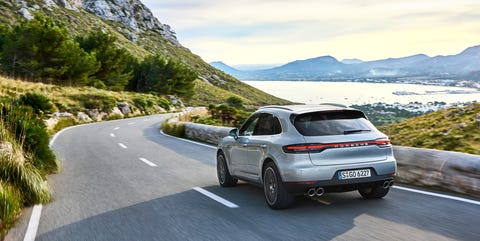
Porsche announced today that the second generation of its phenomenal Macan crossover will go fully electric. Apparently the decision was made this past July, with part of the deciding factor being the desire to invest in electrified vehicles at the Leipzig, Germany, plant where the Macan is currently built. Porsche has said that it wants 50 percent of its new cars to have “an electric drive system” by 2025, and an electric Macan will be a big factor in achieving that. The Leipzig plant currently produces the Macan and the Panamera, with more than 90,000 vehicles rolling off the line every year.
The next Macan will be based on the Premium Platform Electric (PPE) platform that is being developed in conjunction with Audi, which will use the platform to underpin its own all-electric models; PPE will underpin the next-generation Taycan sedan. (The Taycan that is debuting later this year is on a different platform, code-named J1, that will be shared with the Audi e-tron GT.) The Macan will have the same 800-volt tech as the next Taycan and will probably share its electric motors and battery packs, too.
We know that the upcoming, first-gen Taycan—or at least one version of it—will have two electric motors producing 600 horsepower, a range of more than 300 miles, and a zero-to-60-mph time under 3.5 seconds. If those specs carry through to the following generation, then the top-end Macan EV should match or get close to those numbers, too. But expect multiple lower-end variants to have less power and a shorter range than the “Turbo” equivalent. The current Macan does start at less than $52,000, after all, and Porsche will likely want to keep the Macan’s entry-level status intact.
This news is bittersweet. The prospect of a compact, fully electric Porsche crossover is pretty exciting to us, especially if it drives anywhere as well as the current 10Best-winning model does. But part of the existing Macan’s appeal is its varied engine lineup. The Macan is available with a turbocharged inline-four and multiple different turbocharged and twin-turbocharged V-6s in different states of tune.
Porsche says the next Macan will enter production at the start of the next decade, most likely in 2021. It will follow the first Taycan sedan, which will make its debut by the end of this year, and the Taycan Cross Turismo and Sport Turismo wagon variants, which Porsche says will come soon after the standard car. The second-gen, PPE-based Taycan will likely arrive midway through the decade at the earliest.
The 190-MPH Bentley Bentayga Speed Is the World’s Fastest SUV, Just Barely
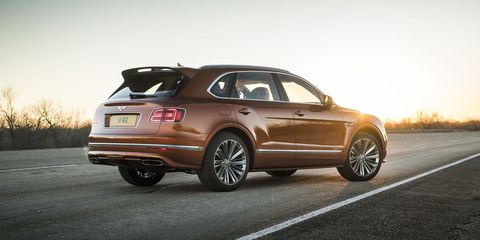
When the Bentley Bentayga came out back in 2016, it claimed the title of “world’s fastest SUV” with its 187-mph top speed. A year later, Lamborghini took that record away with the 190-mph Urus. Now Bentley reclaims the record by a nose with the 2020 Bentayga Speed.
We’ve said previously that the Urus will hit 190 mph flat out. Technically, however, the automaker’s quoted 305 km/h top speed calculates to 189.5 mph. Now, Bentley says the Bentayga Speed will do 306 km/h, which is an honest 190.1 mph.
Now, you might think a 0.6-mph difference is meaningless, but apparently Bentley doesn’t. The British automaker is gleefully calling the Bentayga Speed the “world’s fastest production SUV.” It’s especially silly when you recall that Bentley and Lamborghini are both owned by Volkswagen Group—and the Bentayga and Urus share a platform. Seems there’s a bit of sibling rivalry at play here.
Amazon Invests in Rivian, a Tesla Rival in Electric Vehicles

A potential rival to Tesla in electric cars just got a big boost from Amazon.
The online retail giant is leading a $700 million investment in Rivian, a Michigan company that is developing a battery-powered pickup truck and an electric sport utility vehicle. The automaker announced the new round of investment on Friday, offering few details but saying it would remain independent.
Founded in 2009 by an M.I.T.-trained engineer, R. J. Scaringe, Rivian first showed its truck and S.U.V. at the Los Angeles Auto Show in November. The key feature of each is a chassis that is shaped like a skateboard and includes all the components that propel the vehicles — a large battery pack, axles, suspension, cooling system and four electric motors. The company says its pickup will be able to go up to 400 miles on a full charge.
The deal is the latest example of how the auto industry is being reshaped by new technologies and nimble companies that have raced ahead of many traditional carmakers. While General Motors, Ford Motor and others are scrambling to introduce new electric vehicles, Tesla has become by far the leading seller of electric cars in the United States. Waymo, a division of Google’s parent company, Alphabet, is considered by some analysts to be the leading developer of autonomous vehicles.
“We’re inspired by Rivian’s vision for the future of electric transportation,” Jeff Wilke, Amazon’s chief executive for worldwide consumer, said in a statement. “R. J. has built an impressive organization, with a product portfolio and technology to match. We’re thrilled to invest in such an innovative company.”
An Amazon spokeswoman declined to elaborate on the thinking behind the Rivian investment.
Since 2015, Amazon has been building out its own logistics network, one that is a “global, end-to-end network covering all transportation modalities,” Morgan Stanley said in a research note last month. It owns dozens of planes and has a transoceanic shipping operation, not to mention trucks, rail and other ways to deliver products and packages. The company spent more than $27 billion on worldwide shipping last year.
Amazon relies on contract drivers in passenger cars and trucks to make many last-minute deliveries quicker than it can through delivery partners like the United States Postal Service. Last month, the company said it was testing a delivery device called Scout, which is the size of a large ice chest that can “roll along sidewalks at a walking pace.” The company says it is using the devices to deliver packages to customers in a suburb near Amazon’s Seattle headquarters.
‘300mph’ SSC Tuatara Hypercar Teased in New Video
Remember the SSC Ultimate Aero? It was the American-built hypercar that, back in 2007, briefly stole the title of world’s fastest production car away from the Bugatti Veyron by recording a two-way average speed of 256.18mph. The Ultimate Aero’s successor, the Tuatara, was first announced in 2011, first shown as a concept at the 2013 Dubai motor show and unveiled in production form early in 2018. Now its maker has released a video of the model on the road.
With SSC aiming for the rather ambitious goal of a 300mph top speed, the new car ought to have the specs to match. A mid-mounted, twin-turbo flat-plane-crank 5.9-litre V8 pushes up to 1750bhp to the rear wheels through a seven-speed automated manual gearbox. The car also features a carbonfibre chassis and body, and has a dry weight of 1247kg and an impressive drag coefficient of just 0.279 – both claims better than the Koenigsegg Agera (which currently holds the production car speed record) and Bugatti Veyron.
SSC recently said: ‘Production of the Tuatara is ready to begin, with pre-orders currently being secured by those who wish to own this next-generation hypercar.’ Pricing information hasn’t been announced. However, being such a limited model with just 100 in the pipeline, we can’t imagine it’ll be cheap.
In November 2017, Koenigsegg’s Agera RS took the crown of world’s fastest production car, with a staggering two-way average speed of 277.9mph. Factory test driver Niklas Lija put the car’s 5-litre turbocharged V8 to good use, hitting over 284.6mph in one direction and smashing the Veyron Super Sport’s previous speed of 267.8mph. With the possibility of VAG-backed Bugatti also working on a model to beat this record behind closed doors, SSC certainly has its work cut out…
for the FULL VIDEO, click here: https://www.youtube.com/watch?time_continue=2&v=ywdcgVUWffY
By: Sam Jenkins & Jordan Katsianis, February 14, 2019
For more cars visit: https://www.evo.co.uk/videos/planetevovideos/270541/video_shelby_tuatara.html
Source: https://www.evo.co.uk/

